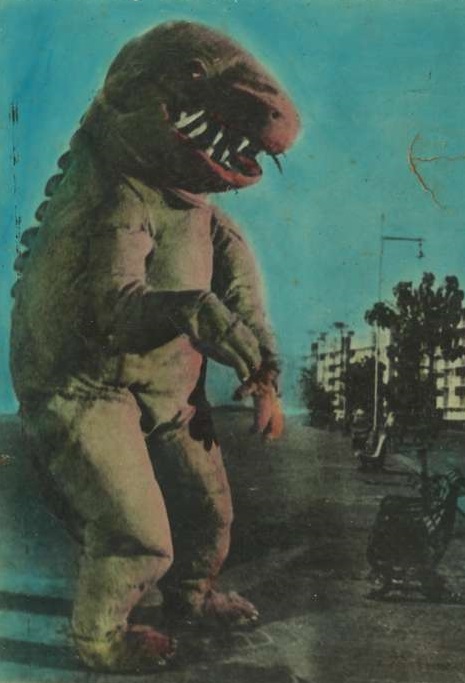Gogola
| |||||||||||||||||||||||||||||||||||||||||
Gogola is a reptilian kaiju who first appeared in the 1966 Indian kaiju film, Gogola.
Design
Gogola's design is reminiscent of those from Gorgo and Godzilla, being a reptilian kaiju that stands upright on its hind legs. It features long, almost humanoid arms with four fingers on each hand. It possesses a short and stumpy tail, and its head is bulky, with two small black eyes and long, sharp teeth, reminiscent of those from goblin sharks.
History
- Gogola (1966)
Gogola
One day, Gogola rose from the sea, terrorising some tourists on one of Mumbai's beaches. The authorities at first deny the kaiju's existence, and later, when compelled to take action, chase Gogola all the way to the sea-shore. The kaiju retreats to Mumbai's Wellington Pier, and starts attacking the city, flooding the streets with water. The military tries to defeat the reptilian monster, but Gogola destroys most of it.
Finally, in a last confrontation, the military kills Gogola.
Abilities
Great Strength
Due to its great size and weight, Gogola, much like any other giant monster, possesses great strength and power.
Fire Breath
According to the film’s script, Gogola was able to shoot a "fiery breath" from its mouth. This can also be seen in the movie's poster, although the beam comes from Gogola's nostrils.

Amphibiousness
Gogola is amphibious, meaning that it can transport itself both in water and land.
Weaknesses
Unlike many kaiju, Gogola is not immune to conventional weaponry.
Trivia
- Gogola was the first and only giant monster movie to be ever produced in India.
- Gogola was portrayed using suitmation. According to D Malvankar, the suit's creator, two or three men were needed in order to operate it.[1]
References
This is a list of references for Gogola. These citations are used to identify the reliable sources on which this article is based. These references appear inside articles in the form of superscript numbers, which look like this: [1]
|
Comments
Showing 36 comments. When commenting, please remain respectful of other users, stay on topic, and avoid role-playing and excessive punctuation. Comments which violate these guidelines may be removed by administrators.
